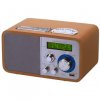It’s time to get back on topic: electronics as a hobby.
From the time I was born in 1942 until about 1955, the only “electronics” in the house was a telephone and a tube radio. In 1955 we added a tube television (a Sylvania TV with fluorescent light surrounding the picture tube). It broke down often and I remember having to replace the picture tube and the many vacuum tubes located in the chassis. The local drug store carried all the vacuum tube types and had a self service tube tester where you could check them yourself.
I began my interest in electronics as a hobby around 1955 when I acquired a tube amplifier and a speaker in a primitive cabinet. I went to Electro Sonic (a local electronics store) and bought a simple record player turntable with an automatic changer. I connected all of these components together learning about the requirements for coaxial cable and other necessities. Very quickly afterwards the transistor took over and eventually completely eliminated the vacuum tube.
At that time in history, I was able to buy a magazine called Popular Electronics that had many DIY articles in it. I started to tinker with those construction plans and carried on building projects throughout my high-school days. I remember building a megaphone to use at football games and make my shouts heard over everyone else. At University of Toronto where I studied Electrical Engineering, we had a physics professor named John Bird (
https://www.electro-tech-online.com/custompdfs/2013/07/bio_John20Bird.pdf). He was the national car rally champion having won the Canadian Winter Rally a number of times. Some of the guys and I set up a car rally of our own and got John Bird to check it out for accuracy. I surprised everyone in the class one day by bringing in a computer I had built to help my driver and I in winning the rally. It was an analog computer that had 3 rotary switches where you could enter the miles per hour you were supposed to drive to 1 decimal point (i.e. – 36.6 mph). When the computer was started, it would advance a mechanical counter every 1/10 of a mile. All the driver had to do was keep the car’s odometer in step with the counter on the computer and the car was on time. When you entered a check point with your score card, you had to be no more than +/- one minute out from the calculated time or lose a point for each minute over or under. John Bird navigated across Canada from coast to coast and only had 6 points against him. On the actual rally the computer made no difference. My driver got stuck in a snow bank that was as high as the roof of the car and we lost the rally. Cost me a case of beer on a bet that we would win.
Electronics as a hobby is nowhere near dead! You can still get DIY magazines such as Circuit Cellar and Elektor although they are heavily geared to digital electronics and microprocessors.
Why not start where it all began: vacuum tubes. A friend of mine in Florida restored an old car from the late 1940s and drove a group of us to lunch in it. He turned on the car radio and out came music from the 1940s. I was thinking at the time “What station would be playing this kind of music in this day and age”? I then figured out that my friend had made a radio transmitter and had it hidden in the trunk of the car that played pre-recorded music from that era.
One of my favorite songs is Radio Ga Ga by Queen. Radio still intrigues me since it’s like fishing for a weak signal in an environment polluted by radio noise. When you can select the signal you are interested in, it’s like having hooked a large fish on your line.
There are many articles on the Internet showing how to construct a vacuum tube radio transmitter for the AM band. Why not start with a project like that and enjoy some history in the process. You can load your iPod with old shows from an era gone by such as Abbott and Costello and The Shadow and amaze your friends when you play them on your AM radio. You can get into restoring old tube radios as a hobby. Check out the Internet. There are many people already doing this and making a huge profit by selling these restored radios. I bought one myself for $300.
If you prefer a kit, you can construct a guitar amplifier from the following vendor:
https://tubedepot.com/



